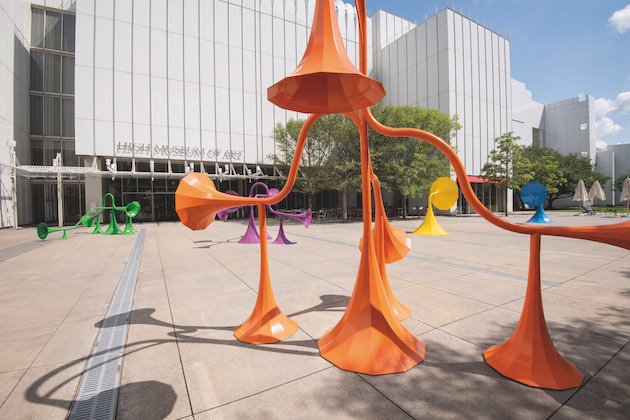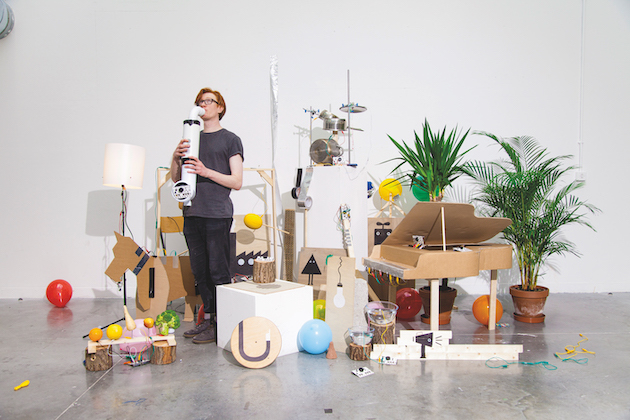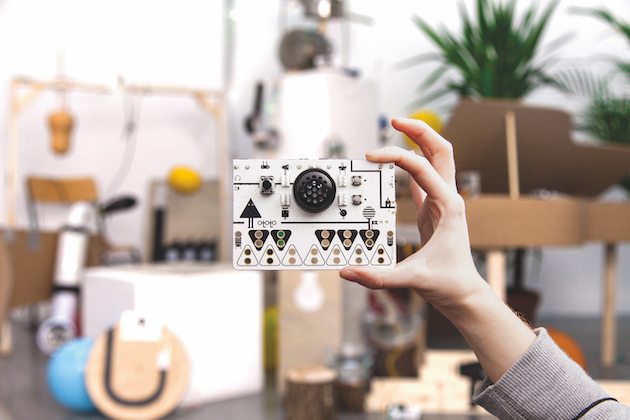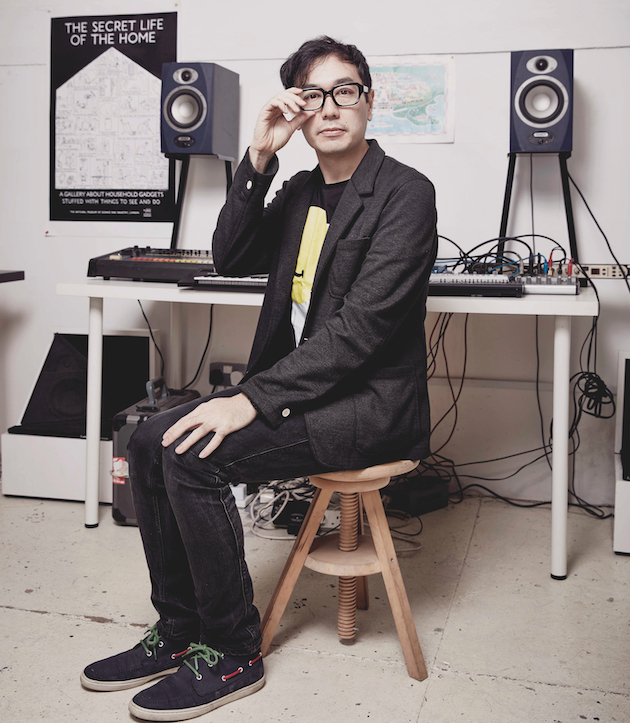
Editor Priya Khanchandani speaks to Yuri Suzuki about his work bringing the sense of hearing front-and-centre through innovative sound installations
Materiality and touch has long dominated both design and the discourses around it. In recent years, though, the discipline has begun to refocus on other senses. London-based artist, designer and musician Yuri Suzuki has been at the vanguard of bringing the sense of hearing to the fore.
In September, Suzuki opened Sound in Mind, an exhibition at the Design Museum in London (having been a designer-in-residence there back in 2012), exploring how sound allows us to interact with the world around us. He is also opened an installation, The Welcome Chorus, at the Turner Contemporary in Margate, which uses AI to generate a sonic tribute to the seaside region.

Born in Tokyo, Suzuki moved to London in 2005 to study product design at the Royal College of Art (RCA). Since establishing his own studio in 2010, he has built bespoke mechanical instruments for the pop musician Will.i.am, worked with Google to develop an augmented reality Android app that transforms paper into instruments, and designed a children’s playground oriented around creating and distorting sound. Last winter, he became a partner of the international design agency, Pentagram.
PRIYA KHANCHANDANI: What do the works curated for Sound in Mind express about sound?
YURI SUZUKI: I really wanted to have this show at the Design Museum because they’ve never done a sound-related show before. The exhibition is divided into two categories. One is more about the inspiration and process of my projects, and how my practice developed. The second is more social.
I think sound is a really strong method of communication. Humans have five senses, but from the beginning, visual communication has been very popular in design. Food design has become quite popular over the past couple of decades and haptic design has developed quite a lot. But what about hearing? I don’t think sound design itself has been considered very well. People treat sound design as if it’s about making special effects for sci-fi films or something. My proposition is slightly different: it’s more about the designer’s perspective, and how we can use it as a tool to communicate better. And I want to improve how we relate to our environment.

PK: How do the projects in the exhibition help us relate to our environment?
YS: One aspect of the project is social engagement, and how sound objects can help people increase communication. I’ve had dyslexia since I was a child, which makes it difficult for reading, writing, and learning musical scores. If you open a score it’s almost impossible to understand. One project, Colour Chaser (2010), is a device that translates drawings into sound. I wanted to try to make a new musical notation that even dyslexic people can understand immediately.
PK: You also have a project at Turner Contemporary in Margate, The Welcome Chorus.
YS: Margate is a place that has been depressed for a long time. Recently a change is happening – I’m not sure if it’s a good thing or not – a sort of gentrification. I would say it has some positive aspects. So many young couples from the East End [of London] are moving to Margate and starting new businesses, new communities and bringing a new creativity, which can really improve the town itself. But the problem is the division with the people who were living in Margate in the first place. They call the people who came from London ‘DFL’: down from London. And I’m not comfortable with this, because communities should be merged. I think that sound and music are still really strong tools for getting people to collaborate. Margate has five or six choir groups, but there are no songs about Margate or Kent. My brief is to try and create a collaborative choir celebrating the county with as many pieces as possible. So this project is allowing 2,000 people to come together to make one song.
PK: The Welcome Chorus involves AI – how are you using this as a tool?
YS: AI is like a small child in a way, it doesn’t know anything. So we just supply information. It’s like developing a brain. The idea is to have people speak lyrics about how they experience Kent, and we teach the AI this, and the melodies that people hum or sing. The AI will generate new music from there. I’m basically using AI as a platform to get many people to cooperate together. We have 12 horns with speakers, and each horn represents one district of Kent. Every 15 minutes, they will play music celebrating the country, and every 15 minutes the music will be totally different. For me, AI is an amazing tool for music production.

PK: Your practice is focused on the boundary of sound and technology, but you trained as an industrial designer. How and why did you transition?
YS: I initially tried to be a musician. I was into brass music; I used to play trombone. I loved rock, jazz, ska, all kinds of music when I was a child. But because I had dyslexia, I couldn’t read a musical score, and so I couldn’t be a professional musician. So I went and used my computer to make basic electronic music, because it doesn’t need you to read scores at all.
I became a DJ after that and I moved to Berlin for half a year. I released a record but I wasn’t successful at all. It was a very, very tough time. I decided to be a designer after that. So that’s why I came to London and studied product design.
The RCA was an amazing place to study, because there are so many amazing people and everyone’s super good at dedicating themselves to one direction, material, shape and so on. But I didn’t have a background in studying materials and forms. I thought about what I did have, and decided to combine music from a design perspective.
PK: Last year, after almost a decade of owning your own studio, you joined Pentagram. What made you decide to shut up shop and join a company?
YS: I think it’s really because of Daniel Weil, because I’ve admired his works like the Radio in a Bag (1982) for a long time. He’s playing with technology to bring up the level of beauty in electronic products. He’s been a great mentor for me, and he asked me to join. It’s a really nice opportunity for me to learn again – I feel like I’m back in a school in a way. And Pentagram is giving me so many great opportunities at the moment.
PK: Has Pentagram’s focus on graphic design and branding influenced your work?

YS: That’s one of the unique things we’re working on, actually. A branding agency has long meant making a graphic logo for the company, but now more companies are interested in sound identity: McDonald’s, Intel. People are communicating with sound – these days we don’t text as much and people are instead talking into devices. And if you think about IoT [Internet of Things] devices such as Alexa, there’s no keypad. You talk to it. So people are now realising that sound communication is more direct.
PK: Does this mean we are going back to the era of radio-style jingles?
YS: Well, it’s more about how sound is presented. What sounds are people listening to at the moment? It could be a notification sound from an iPhone, or a podcast. And also engagement – if you enter a building, what background music is playing? Something I’m really curious about, actually, is the music that plays when you’re put on hold by a big company. There always has to be music present while people are waiting. So there’s so many perspectives to presenting music and how we can make it part of the core of a company’s identity, and how we can stretch it into a different format, which is really fascinating for me.
Another thing is the electric car – they don’t have sound in the way petrol vehicles do. The UK and US have made regulations about the amount of sound they have to produce, for safety reasons. So now car manufacturers are thinking about the identity of the sound as well.
PK: Technology is making the world more intangible. Do you think this has a negative impact or is technology a positive force?
YS: Everything was inside a computer for a long time. But in the past 20 years, many companies have started making hardware. Humans need to have some tactility, some physicality to create. But I’m positive because technical development has helped us to directly communicate with computers. It used to be that you had to type in a very complicated programming language, almost impossible to understand. But now we can communicate with sound – for example, by saying ‘Hey Alexa’ or ‘Hi Siri’.
PK: Do you think sound has the potential to shape human behaviour?
YS: I think sound directly communicates with your emotions. If you stand in front of a view, you can avoid it by closing your eyes. But sound is totally different: even if you cuff your ear you can hear vibrations. And this can be used for really bad things – the US Army uses sounds for suspected terrorists as torture. They put in headphones and keep repeating the same phrase again and again for three or four hours. It’s the most effective way for them to get the results they want. Sound is really powerful – but it can be used in a super positive or a super negative way. I feel like we should use it in a positive way.















